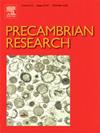Neoarchean accretionary and collisional tectonics in the southern North China Craton: Implications for crustal growth and plate tectonic styles
IF 3.2
2区 地球科学
Q2 GEOSCIENCES, MULTIDISCIPLINARY
引用次数: 0
Abstract
Archean continental crust primarily consists of TTG (tonalite–trondhjemite–granodiorite) gneisses and greenstone belts. Understanding their origins and tectonic settings is crucial to deciphering continental growth and associated geodynamic regimes on early Earth, which remain highly debated. The North China Craton, one of the largest cratons, experienced significant crustal growth and reworking during late Neoarchean (ca. 2.6–2.5 Ga), but the mechanisms and geodynamic settings remain uncertain. This review assesses the field relations, structural styles, metamorphic features, and magmatic evolution of two representative Neoarchean TTG-greenstone terranes (Dengfeng and Angou) in the southern North China Craton to evaluate different geodynamic models and their roles in continental crust growth. The Dengfeng and Angou complexes, dominated by ca. 2.55–2.50 Ga TTG gneisses, metavolcano-sedimentary assemblages, and high-Mg diorites, with several generations of mafic and felsic intrusions, are subdivided into several lithostructural units with distinct geochronological, structural, geochemical, and metamorphic characteristics. These are interpreted as juxtaposed remnants of intra-oceanic arc/forearc complexes, accretionary complexes, and a continental margin sequence, recording Neoarchean divergent and convergent plate margin processes from seafloor spreading, subduction initiation, forearc accretion to arc–continent collision. The formation of juvenile intra-oceanic arc/forearc complexes, accretion of ocean plate stratigraphy/mélanges, and final arc–continental collision reflects active plate tectonics driving both vertical and lateral continental growth during the late Neoarchean. Metamorphic and thermodynamic modeling suggests a warmer Neoarchean paleo-subduction zone compared to Phanerozoic average slab-top geotherms, likely due to the hotter mantle and subduction of young and short-lived oceanic crust (<30 Myrs). Such accretionary and collision tectonics, characterized by intra-oceanic warm subduction and soft collision, alongside coexisting mantle plume tectonics elsewhere, may have been two key mechanisms in constructing and recycling late Archean continental crust, promoting mantle heat loss and regulating surface environments as today. Finally, we suggest some future research directions to further investigate crustal evolution and tectonic styles from the perspective of the North China Craton.

求助全文
约1分钟内获得全文
求助全文
来源期刊

Precambrian Research
地学-地球科学综合
CiteScore
7.20
自引率
28.90%
发文量
325
审稿时长
12 months
期刊介绍:
Precambrian Research publishes studies on all aspects of the early stages of the composition, structure and evolution of the Earth and its planetary neighbours. With a focus on process-oriented and comparative studies, it covers, but is not restricted to, subjects such as:
(1) Chemical, biological, biochemical and cosmochemical evolution; the origin of life; the evolution of the oceans and atmosphere; the early fossil record; palaeobiology;
(2) Geochronology and isotope and elemental geochemistry;
(3) Precambrian mineral deposits;
(4) Geophysical aspects of the early Earth and Precambrian terrains;
(5) Nature, formation and evolution of the Precambrian lithosphere and mantle including magmatic, depositional, metamorphic and tectonic processes.
In addition, the editors particularly welcome integrated process-oriented studies that involve a combination of the above fields and comparative studies that demonstrate the effect of Precambrian evolution on Phanerozoic earth system processes.
Regional and localised studies of Precambrian phenomena are considered appropriate only when the detail and quality allow illustration of a wider process, or when significant gaps in basic knowledge of a particular area can be filled.
 求助内容:
求助内容: 应助结果提醒方式:
应助结果提醒方式:


